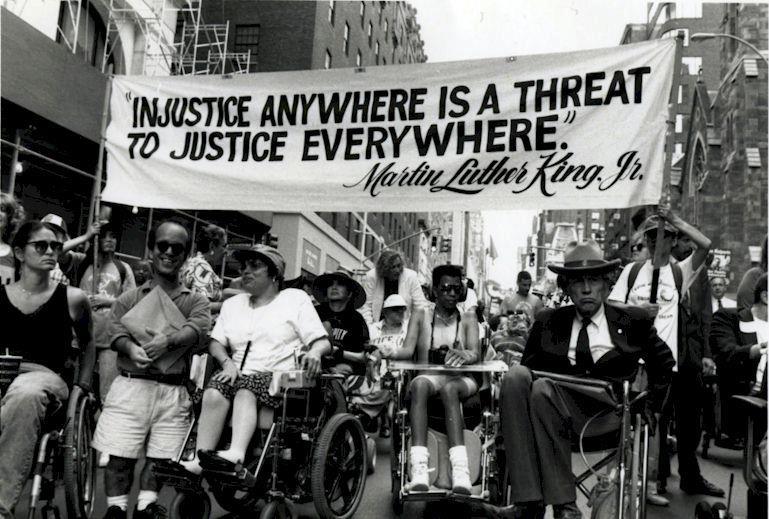Part 2 of 4 of the series When Life and Death is “A Matter of Policy”
Annnnnnnnnd we’re back… in part one of this series, I detailed one policy driven by No Discernable Medical Purpose (NDMP), and that’s the “no foreign ventilator” policy hospitals have, affecting me in the past and maybe at points in the future.
In the past, I blogged about paramedics not wanting to move a dude suffering cardiac arrest “because liability,” No Discernable Medical Purpose (NDMP).
Here in the NY metro area especially, paramedics have been in the spotlight lately… not for good reasons, but in connection with the death of Staten Island gentle giant Eric Garner. Garner, known in his neighborhood as “Big E,” was murdered in broad daylight by an illegal NYPD chokehold for talking back to cops who were harassing him for a past pattern of selling “loosies” (single cigarettes). Garner, who wasn’t even selling anything that day, said “this stops today!” and “please just leave me alone,” among similar things, which apparently constituted resisting arrest and justified initiating force against him—an unarmed man—straight up police brutality. Here in NY, Garner’s murder has occupied conversations, newsprint, blogprint, radio and TV, and the role of the paramedics who seemed to make no effort to resuscitate him was/is being investigated, and the EMS team involved was suspended pending the investigation.
It’s evident from the horrifying footage of Garner’s death that none of the normal medical protocols were followed, and all nurses and doctors who have talked about it on the record (see Eyewitness News 7 report) are unanimously flummoxed and dismayed at the unusually lackadaisical approach EMS took. The New York Times spoke to Dr. Alexander Kuehl, who led Emergency Medical Services in New York City during the ’80s. “She certainly didn’t do her job,” he said of the paramedic girl on the infamous cell phone video of the Garner killing.
“She’s totally overawed by the cops. She doesn’t do her assessment at all. There was something very peculiar about her approach.” (full NYT article)
We may never know the full story. It’s apparent from the horrendous footage that the cops waylaid EMS, saying “not yet,” and also telling the crowd Garner was fine and still breathing in order to avert the whole neighborhood going into full-on rioting (crowd control). But that two EMTs + two paramedics took the NYPD assailant’s word for it and didn’t intervene in any of the usual ways is more than a little discouraging. The decisions made, whether directed by the NYPD on the scene, or driven by weird liability fear-related policies, or the EMS supervisor, or all of the above, self-evidently do not reflect advocating for your patient or serving Any Discernable Medical Purpose.
Recently an EMS-related surreal hospital policy also grabbed headlines (in conjunction with the increased scrutiny around the VA scandal) when the policy directing staff anywhere outside of the main buildings to CALL 911 if a patient collapses was followed, and killed a Vietnam veteran who, through unlucky happenstance, had a heart attack in the hospital cafeteria.
The AP reported:
ALBUQUERQUE, N.M. (AP) — A veteran who collapsed in an Albuquerque Veteran Affairs hospital cafeteria — 500 yards from the emergency room — died after waiting around 20 minutes for an ambulance, officials confirmed Thursday.
It took between 15 and 20 minutes for the ambulance to be dispatched and take the man from one building to the other, which is about a five-minute walk, officials at the hospital said.
Kirtland Air Force Medical Group personnel performed CPR until the ambulance arrived, VA spokeswoman Sonja Brown said.
Staff followed policy in calling 911 when the man collapsed on Monday, she said. “Our policy is under expedited review,” Brown said.
Full story here: Veteran dies waiting for ambulance in VA hospital

In the initial local TV News reports, the implicated hospital said simply “we followed policy.”
“Just following orders.”
Sadly, this is yet another instance of “No Discernable Medical Purpose” (NDMP). The best medical treatment for this veteran easily WAS NOT waiting for an outside ambulance, after all “every second counts” with a heart attack. What he needed was heroic action by the staff hoofin’ it to get him to the Emergency Room with all possible rapidity, where cardiac crises are something U.S. medicine is set up to handle really well. If their Emergency Dept. has no one who can rapid response with a gurney to code blues in adjacent buildings, that is a matter of leadership and policy too, NDMP as it was not serving a legit medical goal.
Deference to whacked-out policies is baffling, especially in the United States, where you’d expect a bit more spunk and middle-finger wielding to authority figures from the descendants of rebellious colonists who sparked a revolution over the British effort to inhibit their tea smuggling and rum running (among other things). Here, that meek obedience—maybe even “willful blindness“—the higher-ups like to cultivate led to horrible consequences. Sometimes disobedience is needed, even essential, as I also discussed in the post Law and Order: When Is It Wrong to Follow The Law?
In Part 3, I’ll look at the psychology behind the tendency to OBEY, bad incentives at the VA, and how these problems can be ameliorated.
Nick
2/4 Series When Life and Death is “A Matter of Policy”
In Part 3, the Milgram experiment, James Madison, and hospital ethics
Part 4: activism and rays of hope from medical bloggers
or go back to Part 1: introduction to the series/weird ventilator rule
